Lizards are unique reptiles that have recently become very popular as exotic pets, and many pet enthusiasts are opting for rare, colorful, eye-catching lizards as their pets. Because of their high demand, these colorful lizards are traded in exotic pet markets, and many are also illegally traded. We have come up with a list of the 15 Most Colorful Lizards in the world that are naturally found in various habitats.
Lizards usually have coloration for many purposes, such as to warn off their rivals from their territory, camouflage themselves against dangerous predators, and absorb extensive heat while basking. Lizards also have the ability to occasionally change their body colors for these purposes very quickly and dramatically.
15 Most Colorful Lizards
1) Mexican Alligator Lizard

| Name | Mexican Alligator Lizard |
| Scientific Name | Abronia graminea |
| Size | 160 mm (6 inches) |
| Location | Highlands of Mexico |
| Diet | Insects and Arthropods |
Mexican alligator lizards are one of the most exotic, colorful lizards in the world and are very popular among lizard pet enthusiasts. They are deep emerald green and coral (or teal) blue in color.
They have shiny scales detailed with black markings or dots. The males of these species are more vibrantly colored to attract potential females during breeding seasons.
Juveniles are often beige or brownish with freckled scales. They have triangular heads and long tails, which account for 50 percent of their length.
2) Common Butterfly Lizard
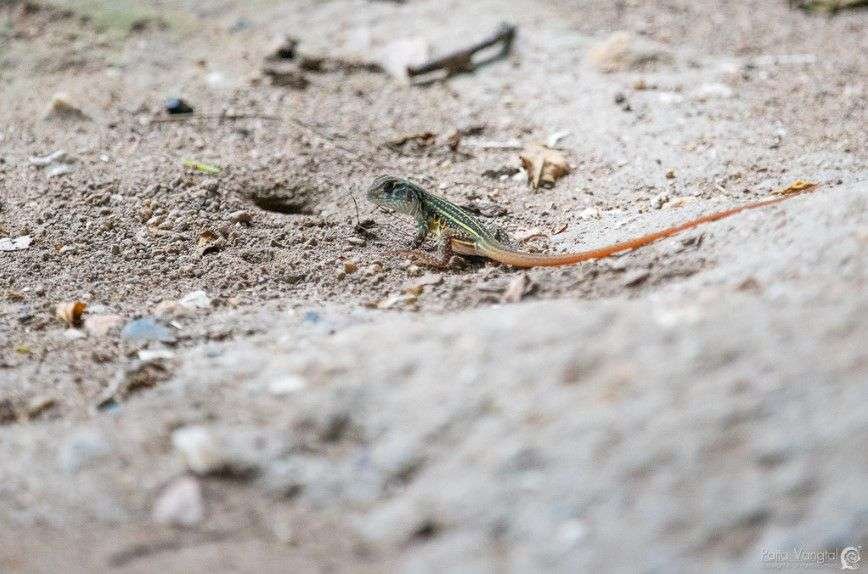
| Name | Common Butterfly Lizard |
| Scientific Name | Leiolepis belliana |
| Size | 18 cm (7.1 inches) |
| Location | forests of Myanmar, Cambodia, Indonesia, Malaysia, Thailand, and Vietnam. |
| Diet | plant vegetation, beetle larvae, butterflies, crabs, grasshoppers, and other insects. |
Common butterfly lizards are distinguished by their butterfly-like flanks, which they use to impress females or warn off predators. They are usually orangish or muddy in appearance, with a reticulated pattern on their scales.
These lizards also have a tinge of blue on their faces and legs. The flanks have distinctive orange and black bars, which look quite tacky. Juveniles of these species have an orangish-red tail with black stripes and circles on their back.
3) Crested Gecko
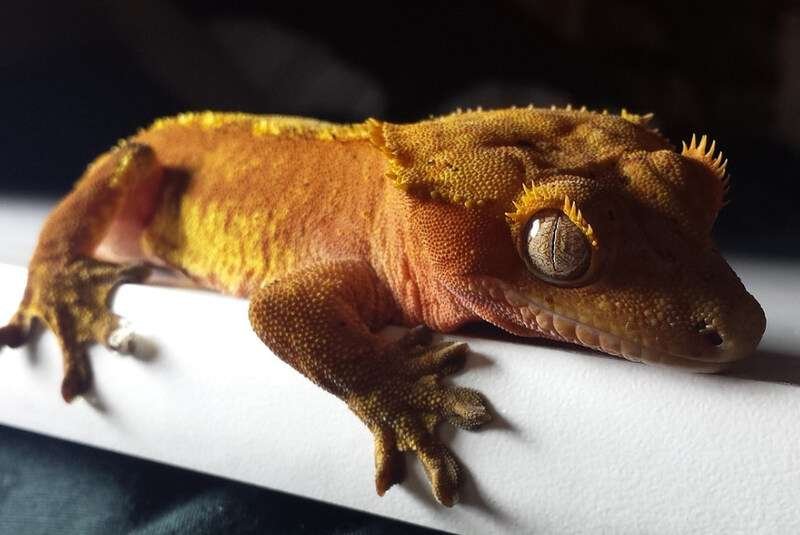
| Name | Crested Gecko |
| Scientific Name | Correlophus ciliatus |
| Size | 15–25 cm (6–10 inches) |
| Location | New Caledonia |
| Diet | Insects and Fruits |
Crested geckos come in a wide variety of patterns and colors; this is the main reason that they are so popular as pet reptiles. They have a wide variety of patterns; some have flame-like markings, while others have a striped or mottled appearance.
But all morphs have a distinctive fringed crest that looks like spines, running from their eyes to the back and on the legs.
They are also known as “eyelash geckos” because of the fringed crest surrounding their eyes that look like eyelashes; the eyelids are absent, though!
4) Mauritius Ornate Day Gecko

| Name | Mauritius Ornate Day Gecko |
| Scientific Name | Phelsuma ornata |
| Size | 12 cm |
| Location | Mauritius |
| Diet | Insects, Fruits, Pollen, and Nectar |
Ornate Mauritius Day Geckos are vividly colored lizards with hues of green, orange, blue, and red. They have vivid patterns of multiple colors on their scales and intricate patterns of colorful stripes or blotches all over their back.
The base color is beige, green, or blue-green, with yellow, brown, or red stripes on their face, neck, back, and tail. Their bellies are off-white. Due to their color, people in some regions believe them to be poisonous, but they are not poisonous and are very safe to be around.
5) Grand Cayman Anole
| Name | Grand Cayman Anole |
| Scientific Name | Anolis conspersus |
| Size | 12-45 cm (5-18 inches) |
| Location | Cayman Island |
| Diet | Fruit flies, small crickets, beetles, moths, butterflies, worms, ants, and termites. |
Grand Cayman anoles are also commonly known as Grand Cayman blue-fanned anoles or the Cayman Islands blue-fanned anoles because of their colorful, blue-colored dewlaps that display high ultraviolet reflectance.
They have bright green to blue-green coloration and long, slender tails. These lizards have bright blue or green splotches on their skin.
Although not chameleons, they tend to change their color to camouflage in plant foliage or plant materials. They usually dwell in woodlands.
6) Jewel Lizard
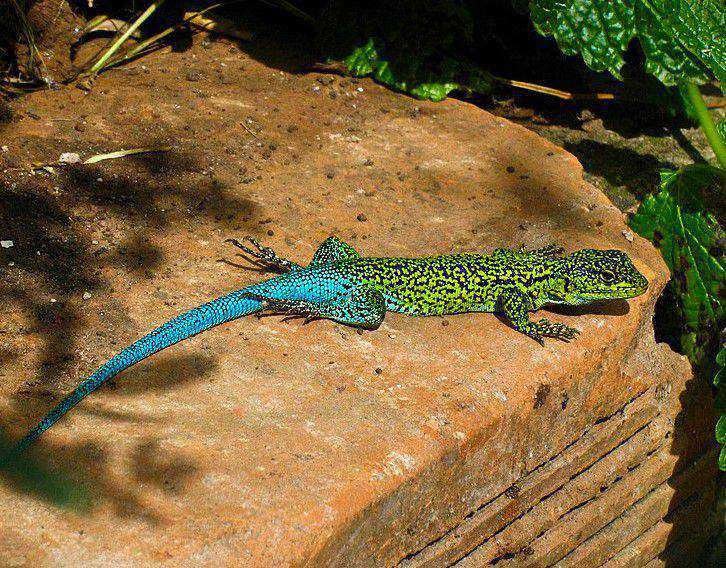
| Name | Jewel lizard |
| Scientific Name | Liolaemus tenuis |
| Size | 5.5 cm |
| Location | Chile |
| Diet | Insects, plant parts, and leafy vegetables |
Jewel lizards are also known as thin tree iguanas, thin lizards, and slender lizards. They are vibrantly colored lizards with dark markings. The coloration of these colorful lizards ranges from orangish-yellow to lime green to dark teal blue.
The color pattern varies according to geographic and sexual variations; some female specimens are quite dark, and some specimens are colored to match their surrounding environments to protect themselves against potential predators.
7) Ocellated Lizard
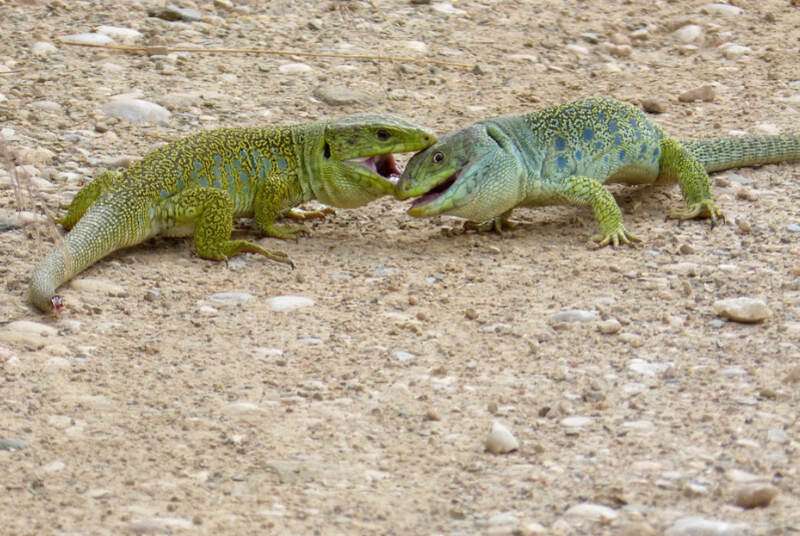
| Name | ocellated lizard |
| Scientific Name | Timon lepidus |
| Size | 30-60 cm (11-23 inches) |
| Location | Spain, Portugal, Gibraltar, southern France, and northwestern Italy. |
| Diet | Beetles, Snails, reptiles, small mammals, frogs, and birds’ eggs |
Ocellated lizards are robust lizards with a notched collar. They have quite a lengthy tail, which is about two third of their bodies.
The male Ocellated Lizards are broader than females, with more powerful legs and curved claws. If you look at the image attached above, you can easily identify their green dorsal scales along with grayish-tan color spots, particularly on the head and tail, along with interrelated black rosettes all over the body.
They have an average lifespan of 8-12 years. Currently, they are categorized under the “near threatened” on IUCN List, meaning they are illegal to trade and capture.
Their bellies are greenish or yellowish. Both the females and males sport vibrant blue spots on and along the flanks. They prefer open spaces to bask in the sun, such as olive plantations, rocky scrub, and grasslands, but they are occasionally found in denser vegetation.
8) Plumed Basilisk
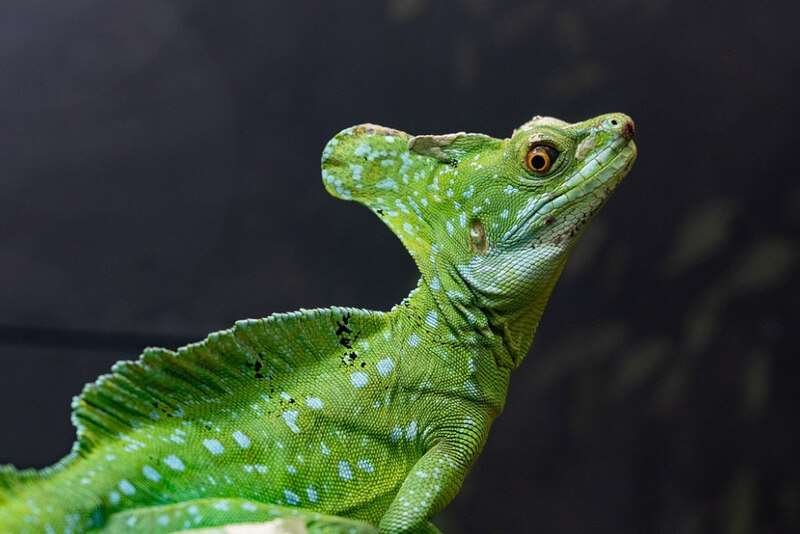
| Name | Plumed Basilisk |
| Scientific Name | Basiliscus plumifrons |
| Size | 25 cm (10 inches) |
| Location | Northern Columbia and Southern Mexico |
| Diet | Insects, worms, spiders, reptiles, fishes, and plant vegetation |
Plumed basilisks are the largest members of the family basilisk; they are also called “little kings” because of the crown-like headpiece they adore.
They are boldly green or sky blue in color, with bluish or whitish speckles scattered all over their bodies and a banded pattern on the entire length of their tails.
Sexual dimorphism is seen in males with long vertebral sails and high cranial crests that run from the neck to the tails. These cranial crests are ridged, which provides some level of safety and protection from predators.
The unique, specialized scales on the bottom of their feet, coupled with their great speeds, provide these lizards with the ability to run over water surfaces. They have orange or yellow-colored irises.
9) European Green Lizard
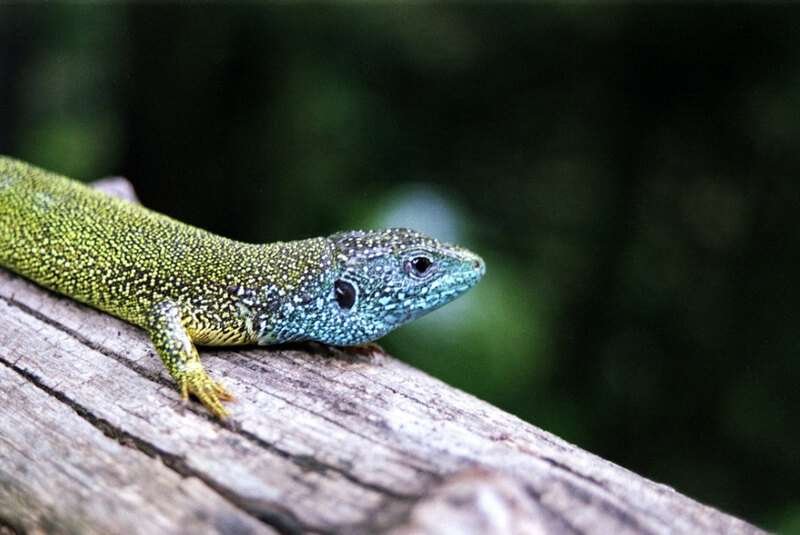
| Name | European Green Lizard |
| Scientific Name | Lacerta viridis |
| Size | 15 cm (5.9 inches) |
| Location | Southeastern Europe |
| Diet | Insects, mice, lizards, fruits, and small invertebrates |
As their name suggests, European green lizards are vividly green lizards with an electric blue-colored throats.
Males have larger heads than females, and their throats are much more colored, whereas females are more uniformly colored, with less bluish color on their throats and patchy black bands on their dorsal scales.
Males are heavily spotted in black. Variations in tail colors are also present; some have green tails, while others have tannish brown tails.
They are great diggers and can dig holes up to a meter in length. They are very alert and fast, and when danger approaches, they tend to climb up trees or bushes and can even jump from one branch to another.
10) Common Collared Lizard
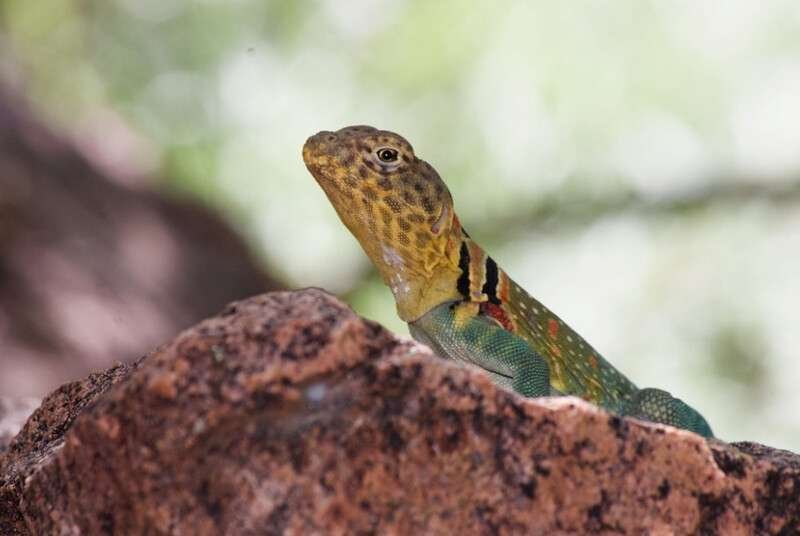
| Name | Common Collared Lizard |
| Scientific Name | Crotaphytus collaris |
| Size | 20–38 cm or (8–15 in) |
| Location | South-central United States and Mexico |
| Diet | Insects, Small Vertebrates, and Plant materials. |
Common collared lizards got their names from their distinctive, colorful, banded collars around their necks, which are three to four in number. They have alternate black and red bands.
Males have vividly colored dorsal scales ranging from bright green, olive brown, bluish, and yellowish. Females are not as colorful as males. Both sexes have big, broad heads and sturdy bodies.
These lizards do not show autotomy; they can’t grow their tails back once they lose them. Females display bright red color splotches when they carry eggs; once the eggs are laid, these splotches diminish. They reside in a wide variety of habitats, but their preferred place is in rocky areas with open vegetation.
11) Lau Banded Iguana

| Name | Lau Banded Iguana |
| Scientific Name | Brachylophus fasciatus |
| Size | 2 cm or (0.79 inches) |
| Location | Lau Islands of Fiji |
| Diet | Leaf, flowers and Fruits |
Lau-banded iguanas are also commonly known as Fiji-banded iguanas because of their presence on Fiji’s Lau Islands and the banded patterns on their dorsal scales.
The males have crisscross stripes or bands of pale blue and green color on their backs, but the females are uniformly solid green with a few pale blue or white spots on their backs. The color patterns help them blend in a while basking in open spaces.
Males have a head-bobbing display to compete with other suitors of their chosen females, and the more excited they get, the faster they bob their heads. These species are critically endangered due to habitat loss, invasive predation, and illegal trading of these exotic species.
12) Gold Day Dust Gecko
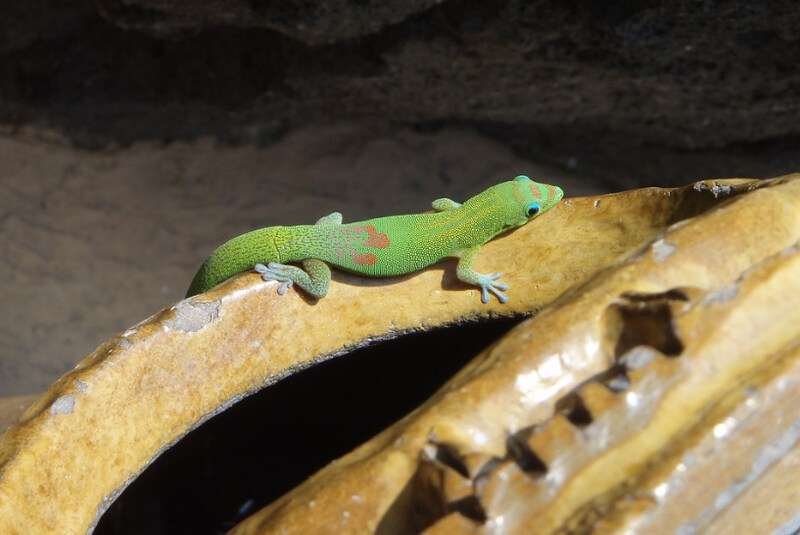
| Name | Gold Dust Day Gecko |
| Scientific Name | Phelsuma laticauda |
| Size | 10-13 cm or (3.9-5.1 inches) |
| Location | Northern Madagascar, Tanzania, Island of Comoros, Hawaii and other Pacific islands. |
| Diet | Insects, Small lizards, and flower pollen and nectar. |
Gold-dust day geckos are brilliantly colored lizards with beautiful golden speckles present on the necks, legs, and tails of these lizards. They are yellowish-green or vibrant green in color, with three rusty-red bands on the snout and two large red tapered bars on the lower back.
The skin area around their eyes is blue, and their bellies are pale white. Their coloration aids in intraspecies recognition and in camouflaging.
They lack eyelids but have pupils with a transparent and fixed plate covering that they wipe constantly using their tongue. Many of us have observed this feature of lizards.
They have toe pads, which aid them in walking on flat, vertical surfaces like bamboo trees or slippery glass; this feature has made them excellent climbers.
13) Filfola Lizard
| Name | Filfola Lizard |
| Scientific Name | Podarcis filfolensis |
| Size | 28 cm or 11 inches |
| Location | Italy and Islands of Malta |
| Diet | Small insects, Ants and Termites |
Filfola lizards are one of the Most Colorful Lizards and have amazing patterns on their scales, with a reticulated or net-like pattern overlaying on their blue or green base bodies. Males are more vibrantly colored, but females are quite dull and brownish in appearance.
They have two to four white vertical stripes running from their necks down to their tails. Males are greenish or brownish and have speckled scales. Some specimens are so severely patterned that they appear to be black with pale blue spots.
They are also known as Maltese wall lizards because they inhabit the Maltese Islands. These lizards are highly opportunistic, and so they are found in rural as well as urban areas.
14) Sand Lizard
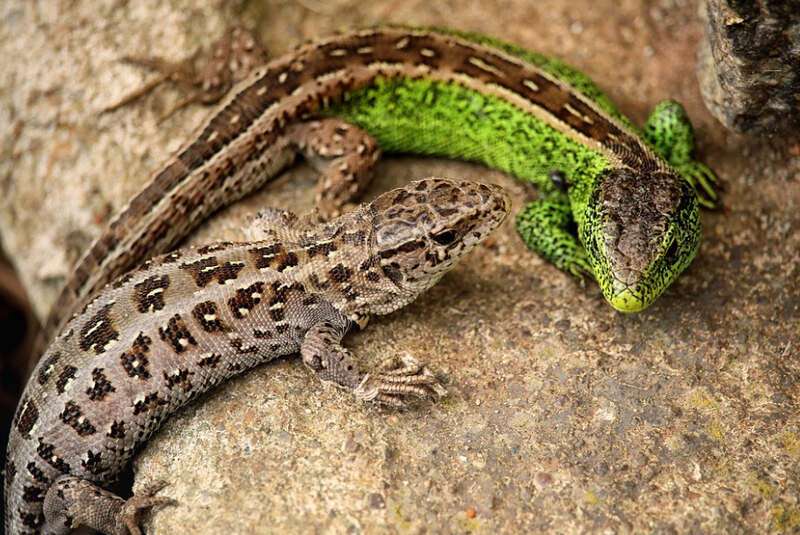
| Name | Sand Lizard |
| Scientific Name | Lacerta agilis |
| Size | 20 cm or 7 inches |
| Location | Throughout Europe |
| Diet | Insects, Slugs, Spiders, fruits, and Flowers |
Sand lizards are very rare and are not easily found in Europe. As their name implies, they are usually sand-brown in color with two bold dorsal stripes, and they have rows of dark splotches all along their backs.
Males have bright green flanks and are more vividly colored during the breeding seasons, making them quite spottable during this period.
They are quite strange lizards and can lift all four of their legs up in the air and lay on their bellies when the ground’s temperature is soaring, and they go through brumation in winter. These lizards have an amazing lifespan of 20 years.
15) Spider-man Agama
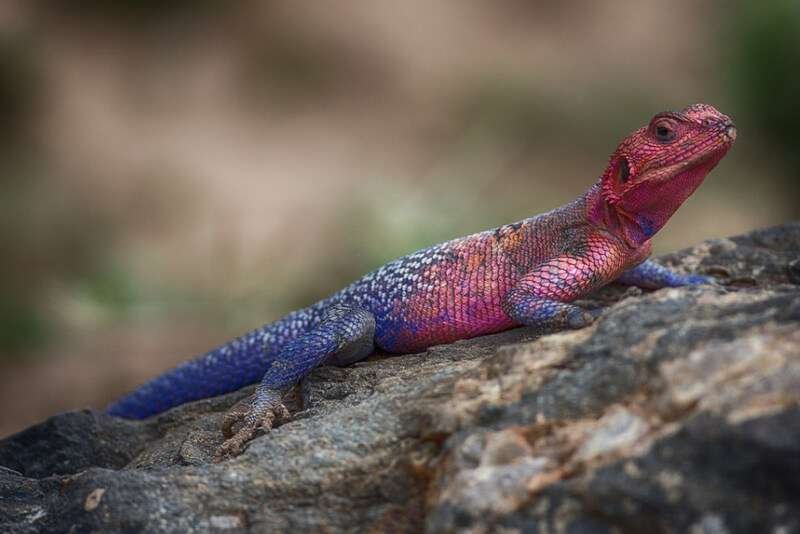
| Name | Mwanza flat-headed rock agama |
| Scientific Name | Agama mwanzae |
| Size | 15-22 cm or (6-9 inches) |
| Location | Tanzania, Kenya, and Rwanda. |
| Diet | Insects, Berries, and Fruits. |
Lastly, on the list of Most Beautiful Lizards in the World, we have the Mwanza flat-headed rock Agama. Mwanza flat-headed rock agama is also known as “spider-man agama” due to its red and blue coloration.
They are quite often confused with rainbow agamas because both species have similar color patterns.
They are flat-bodied, muscular lizards with distinguishing color patterns. The face, throat and upper parts are of a purplish-red color, while the legs, backs, underparts, and tails are darker blue. While they aren’t real superheroes, they are quite intriguing pets and are surely unique reptiles.
Conclusion:
Lizards are surely very cool reptiles to be pets, as they come in a variety of patterns and dazzling colors and are highly intelligent animals. Different species of lizards offer different styles and looks; some are pre-historic or dragon-like, while others look fantastical or majestical.
Also Read:

Hey there! I’ve been the kid who used to love watching all the science stuff and that fascination lead me to choose Zoology as my Major in Graduation. I’m a self-taught writer and spend my time writing scintillating content on animals. I love observing animals behavior and their bond with humans. I want to give my point of view regarding animals i research about. I had done several projects on animals during my graduation and learned their behavior thoroughly.

